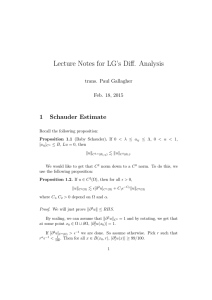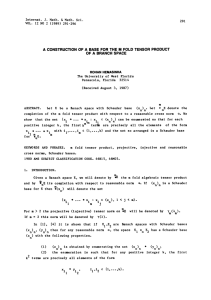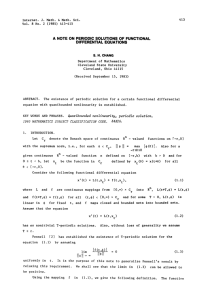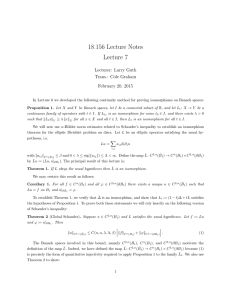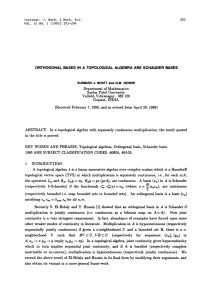GENERALIZED SCHAUDER FRAMES S.K. Kaushik and Shalu Sharma
advertisement
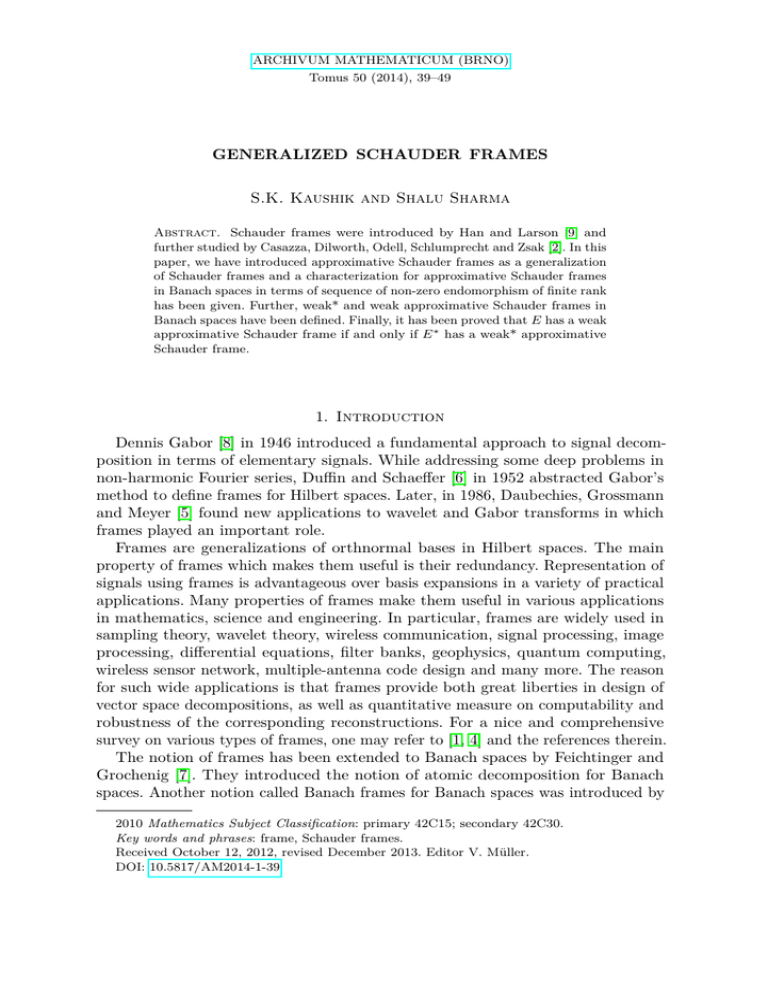
ARCHIVUM MATHEMATICUM (BRNO)
Tomus 50 (2014), 39–49
GENERALIZED SCHAUDER FRAMES
S.K. Kaushik and Shalu Sharma
Abstract. Schauder frames were introduced by Han and Larson [9] and
further studied by Casazza, Dilworth, Odell, Schlumprecht and Zsak [2]. In this
paper, we have introduced approximative Schauder frames as a generalization
of Schauder frames and a characterization for approximative Schauder frames
in Banach spaces in terms of sequence of non-zero endomorphism of finite rank
has been given. Further, weak* and weak approximative Schauder frames in
Banach spaces have been defined. Finally, it has been proved that E has a weak
approximative Schauder frame if and only if E ∗ has a weak* approximative
Schauder frame.
1. Introduction
Dennis Gabor [8] in 1946 introduced a fundamental approach to signal decomposition in terms of elementary signals. While addressing some deep problems in
non-harmonic Fourier series, Duffin and Schaeffer [6] in 1952 abstracted Gabor’s
method to define frames for Hilbert spaces. Later, in 1986, Daubechies, Grossmann
and Meyer [5] found new applications to wavelet and Gabor transforms in which
frames played an important role.
Frames are generalizations of orthnormal bases in Hilbert spaces. The main
property of frames which makes them useful is their redundancy. Representation of
signals using frames is advantageous over basis expansions in a variety of practical
applications. Many properties of frames make them useful in various applications
in mathematics, science and engineering. In particular, frames are widely used in
sampling theory, wavelet theory, wireless communication, signal processing, image
processing, differential equations, filter banks, geophysics, quantum computing,
wireless sensor network, multiple-antenna code design and many more. The reason
for such wide applications is that frames provide both great liberties in design of
vector space decompositions, as well as quantitative measure on computability and
robustness of the corresponding reconstructions. For a nice and comprehensive
survey on various types of frames, one may refer to [1, 4] and the references therein.
The notion of frames has been extended to Banach spaces by Feichtinger and
Grochenig [7]. They introduced the notion of atomic decomposition for Banach
spaces. Another notion called Banach frames for Banach spaces was introduced by
2010 Mathematics Subject Classification: primary 42C15; secondary 42C30.
Key words and phrases: frame, Schauder frames.
Received October 12, 2012, revised December 2013. Editor V. Müller.
DOI: 10.5817/AM2014-1-39
40
S.K. KAUSHIK AND S. SHARMA
Grochenig. Casazza, Han and Larson [3] carried out a study of atomic decompositions and Banach frames. Schauder frames for Banach spaces were introduced by
Han and Larson [9] and were further studied in [10, 11, 12, 14].
Recently, sparsity has become a key concept in various areas of applied mathematics and engineering. Sparse signal processing methodologies explore the
fundamental fact that many types of signals can be represented by only a few
non-zero coefficients when choosing a suitable basis or, more generally, a frame. In
this paper, we introduce a generalization of a Schauder frame called approximative
Schauder frame which has sparsity in its nature in the sense that it can be characterized by a sequence of non-zero endomorphisms of finite rank (Theorem 3.6). A
necessary and sufficient condition for approximative Schauder frames in Banach
spaces is given. Commuting approximative Schauder frames in Banach spaces
has been defined. A sufficient condition for shrinking commuting approximative
Schauder frame has been proved. Weak* and weak approximative Schauder frames
in Banach spaces have been defined. Finally it is shown that E has a weak approximative Schauder frames if and only if E ∗ has a weak* approximative Schauder
frame.
2. Preliminaries
Throughout this paper E denotes an infinite dimensional Banach space over the
scalar field K (R or C) and E ∗ denotes the conjugate space of E. For a sequence
{xn } ⊂ E and {fn } ⊂ E ∗ , [xn ] denotes the closure of linear span of {xn } in the
norm toplogy of E and [f˜n ] the closure of {fn } in σ (E ∗ , E) topology.
Definition 2.1 ([9]). Let E be a Banach space and let {xn } be a sequence in E
and {fn } be sequence in E ∗ . Then the pair ({xn }, {fn }) is called a Schauder frame
for E if
∞
X
x=
fn (x)xn , for all x ∈ E .
n=1
Definition 2.2 ([13]). A Banach space E is said to have bounded approximation
property if there exists λ ≥ 1 such that the identity operator IE : E → E can
be approximated, uniformly on every compact subset of E, by linear operators
of finite rank, of norm ≤ λ, that is, if there exists a constant λ ≥ 1 with the
property: for every compact subset Q ⊂ E and for every > 0 there exists an
endomorphism u = uQ, ∈ L(E, E) of finite rank, of norm kuk ≤ λ, such that
ku(x) − xk < (x ∈ Q).
Definition 2.3 ([13]). A Banach space E is said to have a λ duality approximation
property, if for every > 0 and every pair of finite dimensional subspaces G of E
and Γ of E ∗ , there exists an endomorphism u ∈ L(E, E) of finite rank such that
ku(y) − yk < kyk ,
∗
ku (h) − hk < khk ,
kuk < λ .
(y ∈ G)
(h ∈ Γ)
GENERALIZED SCHAUDER FRAMES
41
3. Approximative Schauder frames
We begin with the following definition of approximative Schauder frames.
Definition 3.1. Let E be a Banach space, {xn } ⊂ E and {hn,i } i=1,2,...,mn ⊂
n∈N
E ∗ , where {mn } is an increasing sequence of positive integers. Then the pair
{xn }, {hn,i } i=1,2,...,mn is called an approximative Schauder frame for E if
n∈N
x = lim
n→∞
mn
X
hn,i (x)xi
for all
x∈E.
i=1
The following is an example of an approximative Schauder frame.
Example 3.2. Let E = l1 . Let {en } be the sequence of unit vectors in E. Define
{xn } ⊂ E, and {fn } ⊂ E ∗ by
e1
e1
, x2 =
, xn = en−1 , n = 3, 4, . . .
x1 =
2
2
f1 (x) = ξ1 ,
f2 (x) = ξ1 ,
fn (x) = ξn−1 ,
n ≥ 3,
x = {ξn } ∈ E .
Now, define {hn,i }i=1,2,...,n ⊂ E ∗ by
h1,1 = f1 ,
h2,1 = f2 ,
h2,2 = f2 ,
hn,i = fi ,
i = 3, 4, . . . .
Note that
lim
n→∞
n
X
hn,i (x)ei = lim
i=1
n→∞
n
X
fi (x)ei = x ,
x∈E.
i=1
Hence ({xn }, {hn,i }i=1,2,...,n ) is an approximative Schauder frame for E.
Remark 3.3.
(1) Every Schauder frame is an approximative Schauder frame. Indeed, let
({xn }, {fn }) be a Schauder frame for E. Put hn,i = fi , i = 1, 2, . . . , n;
n ∈ N. Then ({xn }, {hn,i } i=1,2,...,mn ) is an approximative Schauder frame
n∈N
for E as
n
n
X
X
lim
hn,i (x)xi = lim
fi (x)xi = x , x ∈ E .
n→∞
i=1
n→∞
i=1
(2) An approximative Schauder frame may not be a Schauder frame.
Next, we give an example of approximative Schauder frame which is not a
Schauder frame.
Example 3.4. Let E = c0 , {en } be the sequence of unit vectors in E and {fn }
be the sequence of standard unit vectors in E ∗ . Then, ({en }, {fn }) is a Schauder
frame for E. Define {hn,i }i=1,2,...,n ⊂ E ∗ by
hn,i = fi ,
i = 1, 2, . . . , n, n ∈ N .
42
S.K. KAUSHIK AND S. SHARMA
Note that
lim
n→∞
n
X
hn,i (x)ei = lim
n→∞
i=1
n
X
x∈E.
fi (x)ei = x,
i=1
Hence ({en }, {hn,i }i=1,2,...,n ) is an approximative Schauder frame for E but not a
Schauder frame for E. Indeed, if we let x = {ξn } ∈ E. Then
h1,1 (x)e1 + h2,1 (x)e2 + h2,2 (x)e3 + h3,1 (x)e4 + h3,2 (x)e5 + h3,3 (x)e6 + . . .
= ξ1 e1 + ξ1 e2 + . . .
= (ξ1 , ξ1 , ξ2 , ξ1 , . . . )
6= x .
In the following example, we construct an approximative Schauder frame for
`2 (N) from a sequence which is not a frame for `2 (N).
Example 3.5. Let H = `2 (N) and {en } be the sequence of standard unit vectors
en
in H. The sequence {xn } ∈ H defined by xn =
, n ∈ N, is not a frame for H but
n
there exist a sequence {hn,i } i=1,2,...,n ∈ H such that ({xn }, {hn,i } i=1,2,...,n ) is an
n∈N
n∈N
approximative Schauder frame for H. In fact, if we take hn,i = iei , i = 1, 2, . . . , n;
n ∈ N, then
lim
n→∞
n
X
hn,i (x)xi = lim
i=1
n→∞
= x,
n
X
i ei (x)
i=1
ei
i
x ∈ H.
Further, one may note that ({xn }, {hn,i } i=1,2,...,n ) is not even a Schauder frame
n∈N
for H.
Next, we give a characterization of an approximative Schauder frame in terms
of a sequence of non zero endomorphisms of finite rank.
Theorem 3.6. A Banach space E has an approximative Schauder frame if and
only if there exists a
{vn } ⊂ B(E) of non
Psequence
Pn zero endomorphisms of finite
∞
rank such that x = i=1 vi (x), x ∈ E and sup k i=1 vi k ≤ λ, for some λ > 0.
∗
Proof. Let {xn } ∈ E and
{hn,i } ∈ E be the sequences such that
{xn }, {hn,i } i=1,2,...,mn is an approximative Schauder frame for E where {mn } is
n∈N
an increasing sequence of positive integers. Define
un (x) =
mn
X
hn,i (x)xi ,
x ∈ E , n ∈ N.
i=1
Then for each n ∈ N, un is a well defined continuous linear mapping on E with
dim un (E) < ∞ such that lim un (x) = x, x ∈ E. Also by using the principle
n→∞
of uniform boundedness,
sup kun k < ∞. Without loss of generality we may
1≤n<∞
GENERALIZED SCHAUDER FRAMES
43
assume that u1 6= 0 and un 6= un+1 for all n ∈ N. Define v1 = u1 , v2n = v2n+1 =
1
2 (un+1 − un ), for all n ∈ N.
Then {vn } is a sequence of non zero endomorphism of finite rank in B(E) such
that
n
X
1
vi (x) = u1 (x) + {(u2 (x) − u1 (x)) + (u2 (x) − u1 (x))}
2
i=1
1
(u3 (x) − u2 (x)) + (u3 (x) − u2 (x)) + . . .
+
2
= un (x) ,
x∈E.
Therefore, we have
lim
n
X
n→∞
Also
vi (x) = lim un (x) = x ,
n→∞
i=1
x∈E.
n
X
vi = sup kun k < ∞ .
sup 1≤n<∞
Conversely, taking un =
n
P
i=1
1≤n<∞
vi , n ∈ N, we have lim un (x) = x, x ∈ E. Since for
n→∞
i=1
n
each n ∈ N, un (E) is finite dimensional, there exists a sequence {yn,i }m
i=mn−1 +1 in
mn
∗
E and a total sequence {gn,i }i=mn−1 +1 in E such that
mn
X
un (x) =
gn,i (x)yn,i ,
x ∈ E , n ∈ N,
i=mn−1 +1
where {mn } is an increasing sequence of positive integers with m0 = 0. Define
{xn } ∈ E and {hn,i } ∈ E ∗ by
xi = yn,i ,
i = mn−1 + 1, . . . , mn ,
n∈N
and
(
hn,i =
0,
gn,i
if i = 1, 2, . . . , mn−1 ;
if i = mn−1 + 1, . . . , mn .
Then, for each x ∈ E and n ∈ N,
lim
n→∞
mn
X
Hence {xn }, {hn,i } i=1,2,...,mn
n∈N
hn,i (x)xi = lim un (x) = x .
i=1
n→∞
is an approximative Schauder frame for E.
Remark 3.7. For the converse of the above result we do not require the assumption
n
P
sup vi < ∞.
i=1
Now, in view of the Theorem 3.6 we give definition for approximative Schauder
frame of operators and λ approximative frame of operators of a Banach space E.
44
S.K. KAUSHIK AND S. SHARMA
Definition 3.8. A sequence of finite rank endomorphisms {un } ⊂ L(E, E) is
called an approximative Schauder frame of operators of Banach space E, if
x = lim un (x) ,
n→∞
If
x∈E.
sup kun k ≤ λ, we say {un } is a λ-approximative Schauder frame(of opera1≤n<∞
tors) of E.
The following result gives a relation between λ duality approximation property
and λ- approximative Schauder frame.
Theorem 3.9. Let E be a Banach space such that E ∗ is separabel. Let λ ≥ 1. Then
E has the λ-duality approximation property if and only if E has a λ-approximative
Schauder frame {un }n∈N satisfying
f = lim u∗n (f ) ,
n∈N
f ∈ E∗ .
Proof. Assume that E has λ-duality approximation property. Let {yn } ⊂ E and
{hn } ⊂ E ∗ be dense sequences, Gn = [y1 , y2 , . . . , yn ] and Γn = [h1 , h2 , . . . , hn ].
Then by λ-duality approximation property, for each n ∈ N there exists a finite rank
endomorphism {un } ∈ B(E) such that
1
(x ∈ Gn , n = 1, 2, . . . )
kun (x) − xk ≤ kxk ,
n
1
ku∗n (f ) − f k ≤ kf k ,
(f ∈ Γn , n = 1, 2, . . . )
n
kun k ≤ λ ,
(n = 1, 2, . . . )
since Gn ⊂ Gn+1 , Γn ⊂ Γn+1 and kun k ≤ λ, n ∈ N, it follows that
lim un (x) = x ,
n→∞
x∈E
and f = lim u∗n (f ), f ∈ E ∗
n→∞
Conversely, let E has a λ-approximative Schauder frame satisfying
f = lim u∗n (f ) ,
n→∞
f ∈ E∗ .
So, there exists a sequence of endomorphism {un } ∈ L(E, E) of finite rank such
that
lim un (x) = x ,
n→∞
x∈E
kun k < λ .
This implies that E has λ-duality approximation property.
Definition 3.10. Let E be a Banach space. A sequence of non zero endomorphisms
{un } ⊂ L(E, E) is called a commuting λ- approximative Schauder frame for Banach
space E if it is a λ- approximative Schauder frame satisfying
ui uj = uj ui = ui ,
(i < j)
Next, we give a sufficient condition for shrinking commuting approximative
Schauder frame.
GENERALIZED SCHAUDER FRAMES
45
Theorem 3.11. Let E be a Banach space such that E ∗ is separable and let E
has λ-duality approximation property for some λ ≥ 1. Then E has a shrinking
commuting approximating Schauder frame {vn }n∈N (i.e. such that {vn∗ }n∈N is a
commuting approximative Schauder frame of E ∗ ).
Proof. Let 0 < n < 1, lim n = 0 and let {yn } be a dense sequence in E. For
n→∞
any f ∈ E ∗ , the subspaces G1 = [y1 ] of E, Γ1 = [f ] of E ∗ and for 1 there exists
an operator v1 ∈ L(E, E) of finite rank, such that
v1 |G1 = IG1 , v1∗ |Γ1 = IΓ1 , kv1 k ≤ λ + 1 .
S
For G2 = [v1 (E) {y2 }], Γ2 = v1∗ (E ∗ ) and 2 there exists v2 ∈ L(E, E) of finite
rank, such that
v2 |G2 = IG2 , v2∗ |Γ2 = IΓ2 , kv2 k ≤ λ + 2 .
S
Taking G3 = [v2 (E) {y3 }], Γ3 = v2∗ (E ∗ ) and 3 and continuing in this way
indefinitely we obtain two sequences of subspaces {Gn }, {Γn } and a sequence of
endomorphisms {vn } ⊂ L(E, E) of finite rank. Now for each y ∈ Gn we have
y = vn (y) ∈ vn (E) and
G1 ⊂ v1 (E) ⊂ G2 ⊂ v2 (E) ⊂ G3 . . .
Therefore, vi (E) ⊂ Gj for all i < j. Hence, we have
(i < j, x ∈ E) ,
vj vi (x) = vi (x) ,
i.e. vj vi = vi ,
Similarly we have Γn ⊂
vn∗
(i < j) .
∗
(E ) = Γn+1 (n = 1, 2, . . . )
vj∗ vi∗ = vi∗ ,
(i < j) .
Now
f (vi vj (x)) = vj∗ vi∗ (f )(x) = vi∗ (f )(x) = f (vi (x)) ,
vi vj (x) = vi (x) ,
x ∈ E , f ∈ E∗ , i < j
(x ∈ E, i < j) .
Thus, we have
vi vj = vj v i = vi ,
(i < j) .
Also
vi∗ vj∗ (f )(x) = f (vj vi ) (x) = f (vi (x)) = vi∗ (f )(x) ,
vi∗ vj∗ = vi∗ .
Thus, we have
vi∗ vj∗ = vi∗ = vj∗ vi∗ ,
Further,
S
n
(i < j) .
S
vn (E) = E and so for any arbitrary y ∈ vn (E), lim vn (y) = y, for all
n
n
∈ E which proves the result.
In view of the above theorem we have the following corollary.
46
S.K. KAUSHIK AND S. SHARMA
Corollary 3.12. Let E be a Banach space. If E ∗ is separable and has bounded
approximation property, then E has a shrinking commuting approximative Schauder
frame.
4. Weak* approximative Schauder frames
Definition 4.1. Let E be a Banach space. A sequence of finite rank endomorphisms
{u∗n } ∈ L(E ∗ , E ∗ ) is said to be a weak* approximative Schauder frame for E ∗ if it
satisfies
f (x) = lim u∗n (f )(x) ,
(x ∈ E, f ∈ E ∗ ) .
n→∞
sup ku∗n k ≤ λ, we say {u∗n } is a weak* λ-approximative Schauder frame (of
If
1≤n<∞
operators) of E.
Next, we give a characterization of weak* approximative Schauder frame.
Theorem 4.2. A separable Banach space E has an approximative Schauder frame
if and only if E ∗ has a weak* approximative Schauder frame.
Proof. Let {vn∗ } ∈ L(E ∗ , E ∗ ) be a weak* approximative Schauder frame for E ∗ .
Then sup kvn∗ k ≤ λ < ∞ and for each finite dimensional subspace Γ of E ∗ and
1≤n<∞
n ∈ N there exists a finite rank operator tΓ, n1 on E such that
t∗Γ, 1 = vn∗ (h) ,
(h ∈ Γ)
n
tΓ, 1 ≤ λ + 1 .
n
1
Now, let D be the directed set of all pairs Γ,
n where Γ is a finite dimensional
subspace of E ∗ and n ∈ N and where Γ1 , n11 ≥ Γ2 , n12 if and only if Γ1 ⊃ Γ2
and n11 ≤ n12 . Furthermore, for each d = Γ, n1 ∈ D let td ∈ L(E, E) be a finite
rank endomorphism such that
kt∗d (h) − hk ≤ khk ,
(h ∈ Γ)
and
ktd k ≤ λ .
If f ∈ E ∗ and > 0, then putting d0 = [f ] , n1 it follows that
kt∗d (f ) − f k ≤ kf k ,
(d ≥ d0 ) .
Hence
lim t∗d (f ) = f ,
d∈D
and
ktd k ≤ λ .
(f ∈ E ∗ )
GENERALIZED SCHAUDER FRAMES
47
Then, we have
lim f (td (x)) = lim t∗d (f )(x) = f (x) ,
d∈D
d∈D
(x ∈ E, f ∈ E ∗ )
this implies
w
td (x) → x ,
(x ∈ E) .
Let {yn } be a dense sequence in E. Then we have sequences {dn } ⊂ D and {mn } ⊂
m1 < m2 < . . . and for each n, nonnegative numbers αmn−1 +1 , . . . αmn
N with
Pm
n
with i=m
αi = 1 such that
n−1 +1
mn
X
i=mn−1
1
αi tdi (yj ) − yj <
n
+1
(j = 1, 2, . . . n; n = 1, 2, . . . ) .
Then for the finite rank operators,
un =
mn
X
αi tdi
i=mn−1 +1
we have
mn
X
lim un (yj ) =
n→∞
αi tdi (yj ) = yj ,
(j = 1, 2, . . . )
i=mn−1 +1
and
mn
X
kun k ≤
αi ktdi k ≤ λ + 1
(n = 1, 2, . . . ) .
i=mn−1 +1
This implies lim un (x) = x, x ∈ E. So {un } is an approximative Schauder frame
n→∞
for E.
Conversely, assume that {un } ⊂ L(E, E) be an approximative Schauder frame for
E. Then
x∈E.
lim un (x) = x ,
n→∞
Now, we have
f (x) = lim f (un (x)) = lim u∗n (f )(x) ,
n→∞
n→∞
(x ∈ E, f ∈ E ∗ )
this implies {u∗n } is a weak* approximative Schauder frame.
5. Weak approximative Schauder frames
Definition 5.1. Let E be a Banach space. A sequence of finite rank endomorphisms
{un } ∈ L(E, E) is said to be a weak approximative Schauder frame for E if it
satisfies
f (x) = lim f (un (x)) ,
(x ∈ E, f ∈ E ∗ ) .
n→∞
If here
sup kun k ≤ λ, we say {un } is a weak λ-approximative Schauder frame
1≤n<∞
(of operators) of E.
Next, we give a characterization of weak approximative Schauder frame.
48
S.K. KAUSHIK AND S. SHARMA
Theorem 5.2. A separable Banach space E has a weak approximative Schauder
frame if and only if E ∗ has a weak* approximative Schauder frame.
Proof. Assume that {u∗n } is a weak* λ- approximative Schauder frame for E ∗ .
Then for each finite dimensional subspace Γ of E ∗ and n ∈ N there exists a finite
rank operator tΓ, n1 on E such that
t∗Γ, 1 = u∗n (h)
n
tΓ, 1 ≤ λ + 1 .
n
(h ∈ Γ)
1
Now, let A be the directed set of all pairs Γ,
n where Γ is a finite dimensional
subspace of E ∗ and n ∈ N and where Γ1 , n11 ≥ Γ2 , n12 if and only if Γ1 ⊃ Γ2
and n11 ≤ n12 . Furthermore, for each α = Γ, n1 ∈ A, tα ∈ L(E, E) be a finite rank
endomorphism. Let x ∈ E, f ∈ E ∗ and > 0 be arbitrary. Then by definition of
weak∗ Schauder frame there exist n0 ∈ N such that
|u∗n (f )(x) − f (x)| < (n ≥ n0 ) .
1
Putting α0 = [f ] , n0 ∈ A and using above inequality, we have
|f (tα (x)) − f (x)| = |t∗α (f )(x) − u∗n (f )(x) + u∗n (f )(x) − f (x)|
≤ |t∗α (f )(x) − u∗n (f )(x)| + |u∗n (f )(x) − f (x)|
= |u∗n (f )(x) − f (x)|
< ,
(α ≥ α0 ) .
This implies lim f (tα (x)) = f (x), x ∈ E, f ∈ E ∗ . Hence E has a weak approximaα
tive schauder frame.
Conversely, assume that E has a weak approximative Schauder frame. Then we
have
lim f (un (x)) = f (x) ,
x ∈ E, f ∈ E ∗ .
n→∞
Now,
f (x) = lim f (un (x)) = lim u∗n (f )(x) .
n→∞
n→∞
This implies {u∗n } is a weak* approximative Schauder frame.
Acknowledgement. The authors thank the referee(s) for their valuable suggestions towards the improvement of the paper.
References
[1] Casazza, P.G., The art of frame theory, Taiwanese J. Math. 4 (2) (2000), 129–201.
[2] Casazza, P.G., Dilworth, S.J., Odell, E., Schlumprecht, Th., Zsak, A., Cofficient quantization
for frames in Banach spaces, J. Math.Anal. Appl. 348 (2008), 66–86.
[3] Casazza, P.G., Han, D., Larson, D.R., Frames for Banach spaces, Contemp. Math. 247
(1999), 149–182.
[4] Christensen, O., Frames and bases (An introductory course), Birkhäuser, Boston, 2008.
[5] Daubechies, I., Grossmann, A., Meyer, Y., Painless non-orthogonal expansions, J. Math.
Phys. 27 (1986), 1271–1283.
GENERALIZED SCHAUDER FRAMES
49
[6] Duffin, R.J., Schaeffer, A.C., A class of non-harmonic Fourier series, Trans. Amer. Math.
Soc. 72 (1952), 341–366.
[7] Feichtinger, H.G., Grochenig, K., A unified approach to atomic decompostion via integrable
group representations, Lecture Notes in Math., vol. 1302, Springer, Berlin, 1988, pp. 429–457.
[8] Gabor, D., Theory of communications, J. Inst. Elec. Engg. 93 (1946), 429–457.
[9] Han, D., Larson, D.R., Frames, bases and group representations, Mem. Amer. Math. Soc.
147 697) (2000), 1–91.
[10] Kaushik, S.K., Sharma, S.K., Poumai, K.T., On Schauder frames in conjugate Banach
spaces, J. Math. 2013 (2013), 4, Article ID 318659.
[11] Liu, R., On shrinking and boundedly complete Schauder frames of Banach spaces, J. Math.
Anal. Appl. 365 (1), 385–398.
[12] Liu, R., Zheng, B., A characterization of Schauder frames which are near Schauder bases, J.
Fourier Anal. Appl. 16 (2010), 791–803.
[13] Singer, I., Bases in Banach spaces II, Springer, New York, 1981.
[14] Vashisht, L.K., On φ Schauder frames, TWMS J. Appl. Eng. Math. 2 (1) (2012), 116–120.
S.K. Kaushik,
Department of Mathematics, Kirori Mal College,
University of Delhi,
Delhi 110 007, India
E-mail: shikk2003@yahoo.co.in
Shalu Sharma,
Department of Mathematics, University of Delhi,
Delhi 110 007, India
E-mail: shalusharma_21@yahoo.co.in
